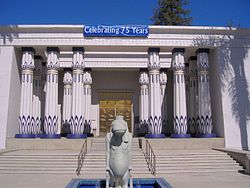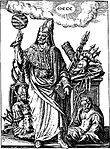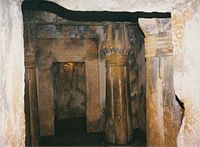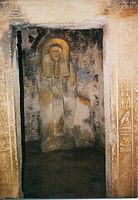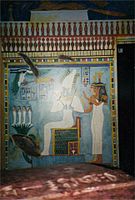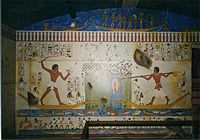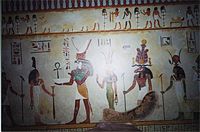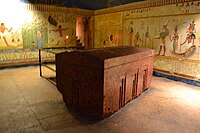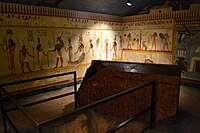
Tutankhamun, Tutankhamon or Tutankhamen, also known as Tutankhaten, was the antepenultimate pharaoh of the Eighteenth Dynasty of ancient Egypt. His death marked the cessation of the dynasty's royal line.

Akhenaten, also spelled Akhenaton or Echnaton, was an ancient Egyptian pharaoh reigning c. 1353–1336 or 1351–1334 BC, the tenth ruler of the Eighteenth Dynasty. Before the fifth year of his reign, he was known as Amenhotep IV.

Nefertiti was a queen of the 18th Dynasty of Ancient Egypt, the great royal wife of Pharaoh Akhenaten. Nefertiti and her husband were known for their radical overhaul of state religious policy, in which they promoted the earliest known form of monotheism, Atenism, centered on the sun disc and its direct connection to the royal household. With her husband, she reigned at what was arguably the wealthiest period of ancient Egyptian history. Some scholars believe that Nefertiti ruled briefly as the female king Neferneferuaten after her husband's death and before the ascension of Tutankhamun, although this identification is a matter of ongoing debate. If Nefertiti did rule as Pharaoh, her reign was marked by the fall of Amarna and relocation of the capital back to the traditional city of Thebes.
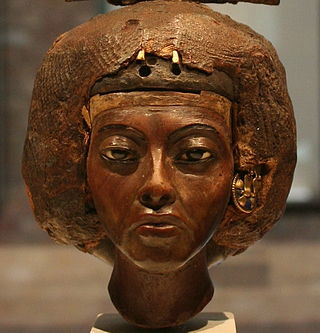
Tiye was the Great Royal Wife of the Egyptian pharaoh Amenhotep III, mother of pharaoh Akhenaten and grandmother of pharaoh Tutankhamun; her parents were Yuya and Thuya. In 2010, DNA analysis confirmed her as the mummy known as "The Elder Lady" found in the tomb of Amenhotep II (KV35) in 1898.

The Museum of Egyptian Antiquities, commonly known as the Egyptian Museum, located in Cairo, Egypt, houses the largest collection of Egyptian antiquities in the world. It houses over 120,000 items, with a representative amount on display. Located in Tahrir Square in a building built in 1901, it is the largest museum in Africa. Among its masterpieces are Pharaoh Tutankhamun's treasure, including its iconic gold burial mask, widely considered one of the best-known works of art in the world and a prominent symbol of ancient Egypt.

Amenhotep III, also known as Amenhotep the Magnificent or Amenhotep the Great and Hellenized as Amenophis III, was the ninth pharaoh of the Eighteenth Dynasty. According to different authors, he ruled Egypt from June 1386 to 1349 BC, or from June 1388 BC to December 1351 BC/1350 BC, after his father Thutmose IV died. Amenhotep was Thutmose's son by a minor wife, Mutemwiya.

KV55 is a tomb in the Valley of the Kings in Egypt. It was discovered by Edward R. Ayrton in 1907 while he was working in the Valley for Theodore M. Davis. It has long been speculated, as well as much disputed, that the body found in this tomb was that of the famous king, Akhenaten, who moved the capital to Akhetaten. The results of genetic and other scientific tests published in February 2010 have confirmed that the person buried there was both the son of Amenhotep III and the father of Tutankhamun. Furthermore, the study established that the age of this person at the time of his death was consistent with that of Akhenaten, thereby making it almost certain that it is Akhenaten's body. However, a growing body of work soon began to appear to dispute the assessment of the age of the mummy and the identification of KV55 as Akhenaten.

Smenkhkare was an ancient Egyptian pharaoh of unknown background who lived and ruled during the Amarna Period of the 18th Dynasty. Smenkhkare was husband to Meritaten, the daughter of his likely co-regent, Akhenaten. Since the Amarna period was subject to a large-scale condemnation of memory by later Pharaohs, very little can be said of Smenkhkare with certainty, and he has hence been subject to immense speculation.

The tomb of Tutankhamun, also known by its tomb number, KV62, is the burial place of Tutankhamun, a pharaoh of the Eighteenth Dynasty of ancient Egypt, in the Valley of the Kings. The tomb consists of four chambers and an entrance staircase and corridor. It is smaller and less extensively decorated than other Egyptian royal tombs of its time, and it probably originated as a tomb for a non-royal individual that was adapted for Tutankhamun's use after his premature death. Like other pharaohs, Tutankhamun was buried with a wide variety of funerary objects and personal possessions, such as coffins, furniture, clothing and jewelry, though in the unusually limited space these goods had to be densely packed. Robbers entered the tomb twice in the years immediately following the burial, but Tutankhamun's mummy and most of the burial goods remained intact. The tomb's low position, dug into the floor of the valley, allowed its entrance to be hidden by debris deposited by flooding and tomb construction. Thus, unlike other tombs in the valley, it was not stripped of its valuables during the Third Intermediate Period.

Kiya was one of the wives of the Egyptian Pharaoh Akhenaten. Little is known about her, and her actions and roles are poorly documented in the historical record, in contrast to those of Akhenaten's ‘Great royal wife’, Nefertiti. Her unusual name suggests that she may originally have been a Mitanni princess. Surviving evidence demonstrates that Kiya was an important figure at Akhenaten's court during the middle years of his reign, when she had a daughter with him. She disappears from history a few years before her royal husband's death. In previous years, she was thought to be mother of Tutankhamun, but recent DNA evidence suggests this is unlikely.
Thutmose, also known as "The King's Favourite and Master of Works, the Sculptor Thutmose", was an Ancient Egyptian sculptor in the Amarna style. He flourished around 1350 BC, and is thought to have been the official court sculptor of the Egyptian pharaoh Akhenaten in the latter part of his reign. A German archaeological expedition digging in Akhenaten's deserted city of Akhetaten, known today as Amarna, found a ruined house and studio complex in early December 1912; the building was identified as that of Thutmose based on an ivory horse blinker found in a rubbish pit in the courtyard inscribed with his name and job title. Since it gave his occupation as "sculptor" and the building was clearly a sculpture workshop, the determination seemed logical and has proven to be accurate.

The Ancient and Mystical Order Rosæ Crucis (AMORC), also known as the Rosicrucian Order, is the largest Rosicrucian organization in the world. It has various lodges, chapters and other affiliated bodies throughout the globe, operating in 19 different languages. It operates as a fraternal order in the mystical Western Esoteric Tradition

Harvey Spencer Lewis F.R.C., S:::I:::I:::, 33° 66° 95°,, a noted Rosicrucian author, occultist, and mystic, was the founder in the US and the first Imperator of the Ancient and Mystical Order Rosae Crucis (AMORC), from 1915 until 1939.

The Egyptian Museum of Berlin is home to one of the world's most important collections of ancient Egyptian artefacts, including the iconic Nefertiti Bust. Since 1855, the collection is a part of the Neues Museum on Berlin's Museum Island, which reopened after renovations in 2009.

Luxor Museum is an archaeological museum in Luxor, Egypt. It stands on the corniche, overlooking the east bank of the River Nile.

Rosicrucian Park is the headquarters of the English Grand Lodge for the Americas of the Ancient Mystical Order Rosae Crucis, located in San Jose, California.
Carl Nicholas Reeves, FSA, is a British Egyptologist, archaeologist and museum curator.
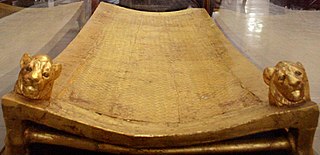
Exhibitions of artifacts from the tomb of Tutankhamun have been held at museums in several countries, notably the United Kingdom, Soviet Union, United States, Canada, Japan, and France.
This page list topics related to ancient Egypt.
